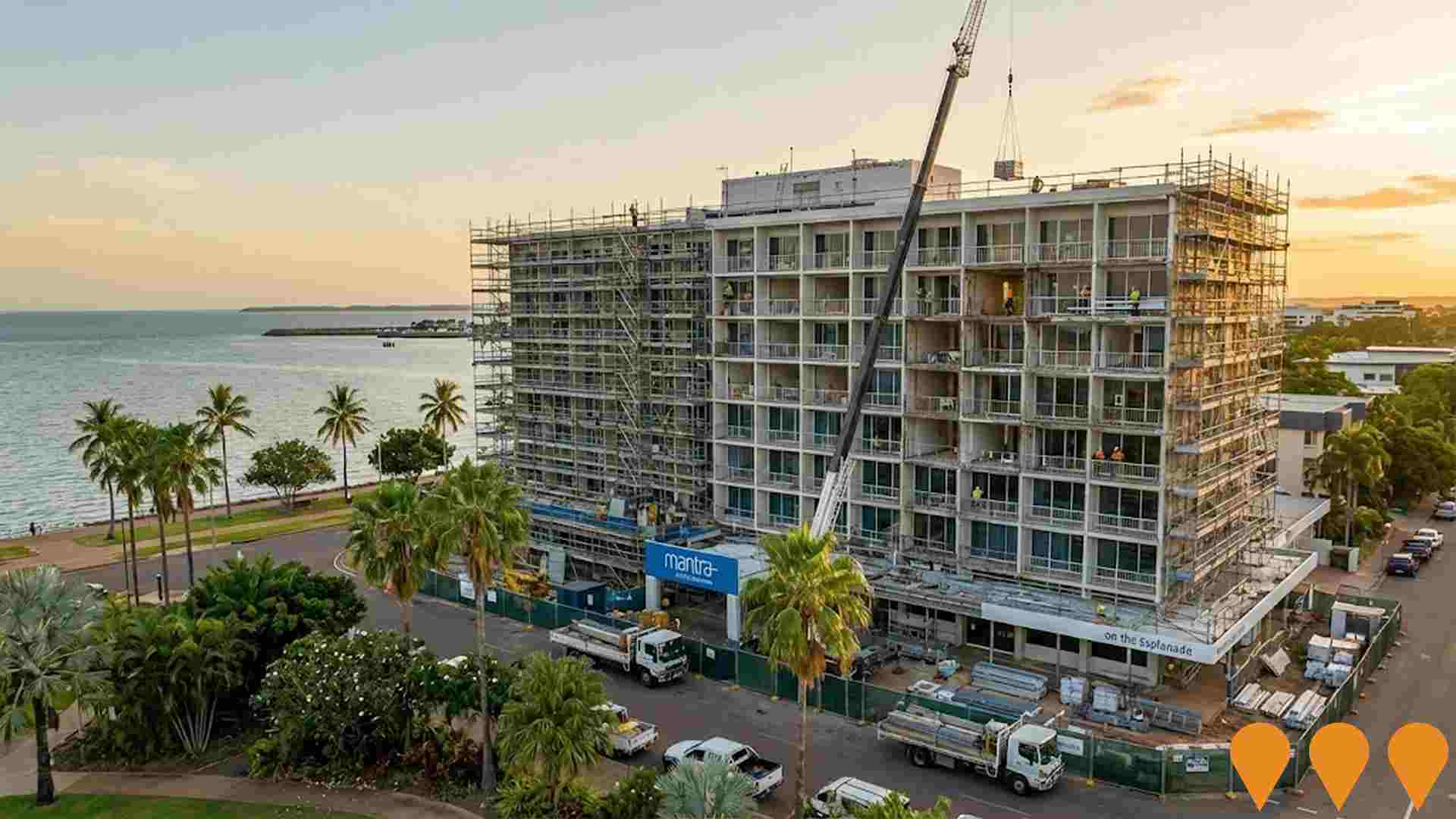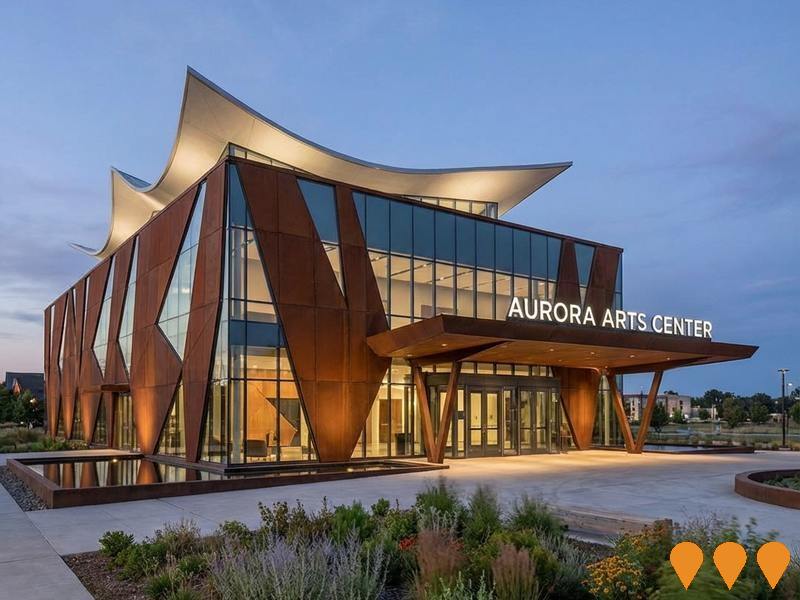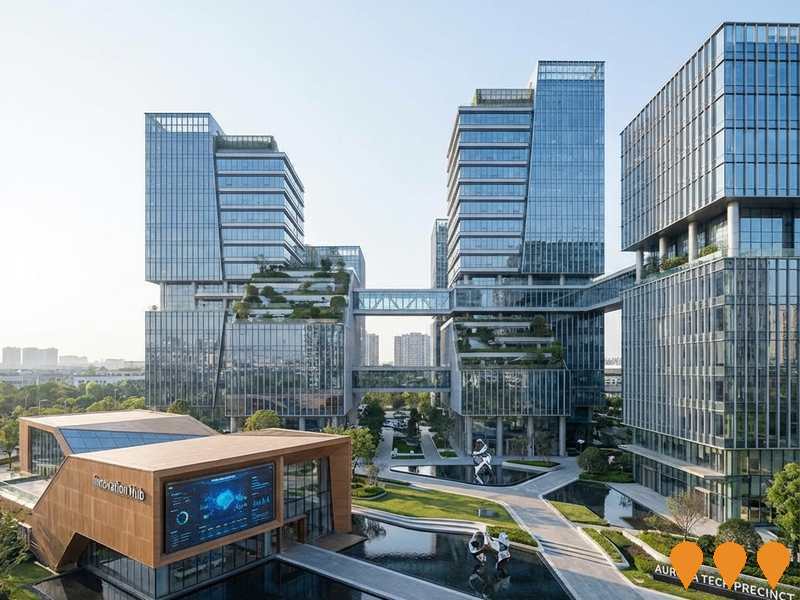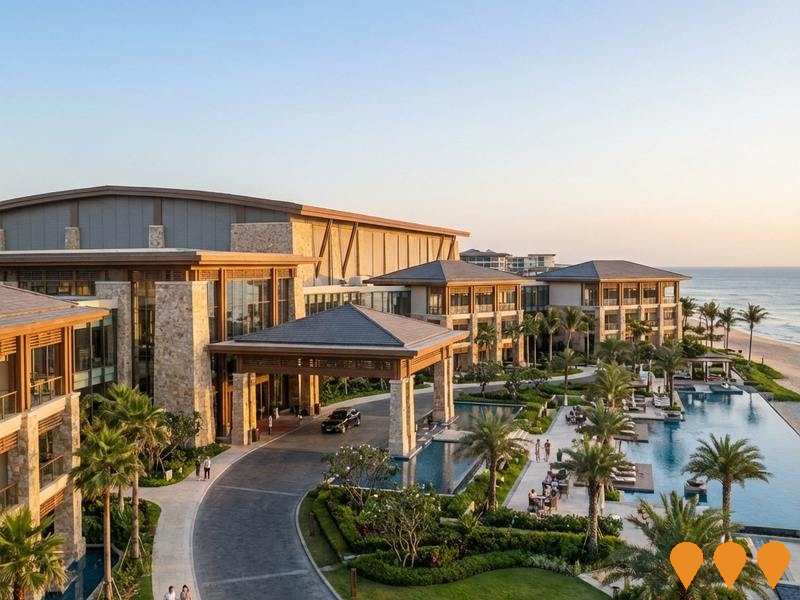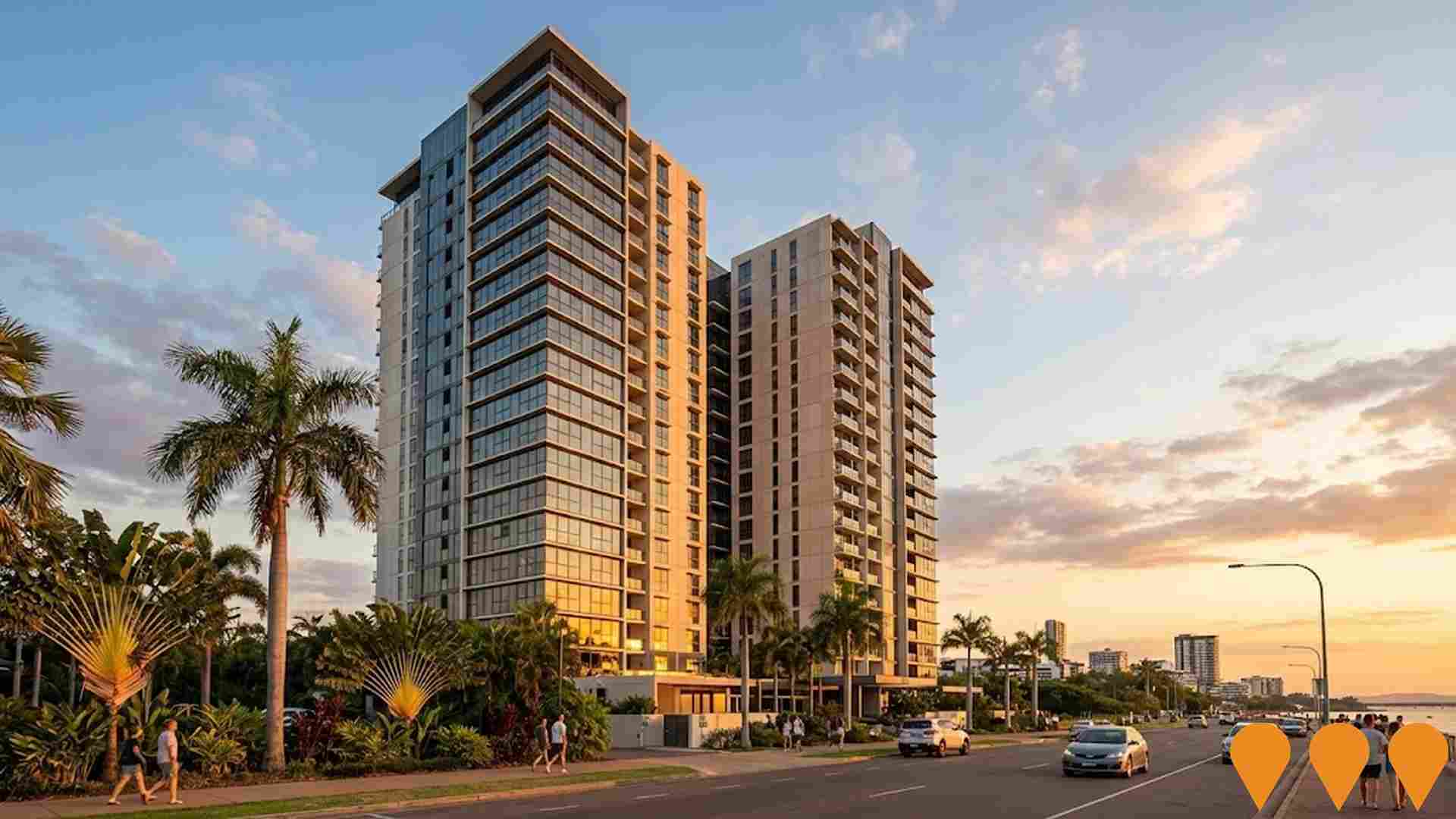Chart Color Schemes
est. as @ -- *
ABS ERP | -- people | --
2021 Census | -- people
Sales Activity
Curious about local property values? Filter the chart to assess the volume and appreciation (including resales) trends and regional comparisons, or scroll to the map below view this information at an individual property level.
Find a Recent Sale
Sales Detail
Population
Darwin City lies within the top quartile of areas nationally for population growth performance according to AreaSearch analysis of recent, and medium to long-term trends
Darwin City's population was around 8,000 as of Aug 2025. This figure reflected an increase of 851 people from the 2021 Census, which reported a population of 7,149 people. The change was inferred from the estimated resident population of 7,872 in June 2024 and an additional 56 validated new addresses since the Census date. This resulted in a density ratio of 2,523 persons per square kilometer, placing Darwin City in the upper quartile relative to national locations assessed by AreaSearch. The city's growth rate of 11.9% since the 2021 census exceeded both the SA3 area (8.6%) and the national average, indicating it as a growth leader in the region. Overseas migration contributed approximately 85.6% of overall population gains during recent periods.
AreaSearch adopted ABS/Geoscience Australia projections for each SA2 area, released in 2024 with a base year of 2022. For areas not covered by this data and to estimate growth post-2032, AreaSearch applied growth rates by age cohort from the ABS's latest Greater Capital Region projections (released in 2023, based on 2022 data). Population projections indicate an above median growth for statistical areas analysed by AreaSearch. The area is expected to expand by 1,899 persons to 2041, with a total increase of 22.1% over the 17 years.
Frequently Asked Questions - Population
Development
Residential development activity is slightly higher than average within Darwin City when compared nationally
Darwin City has received approximately 9 dwelling approvals per year over the past five financial years, totalling 48 homes. No approvals have been recorded so far in FY-26. On average, each dwelling constructed between FY-21 and FY-25 has attracted around 5 new residents per year. This demand significantly exceeds supply, typically leading to price growth and increased buyer competition.
The construction value of these dwellings averages $417,000, aligning with regional patterns. In the current financial year, there have been $76.0 million in commercial approvals, indicating high local commercial activity. Compared to Greater Darwin, Darwin City shows 57.0% higher development activity per person, offering buyers greater choice. However, this level is below average nationally, suggesting potential planning constraints. All new construction has consisted of townhouses or apartments, promoting higher-density living which creates more affordable entry points for downsizers, investors, and first-home buyers. The area has approximately 325 people per dwelling approval, indicating room for growth.
By 2041, Darwin City is projected to grow by 1,771 residents. If current development rates continue, housing supply may struggle to match population growth, potentially intensifying buyer competition and supporting price increases.
Frequently Asked Questions - Development
Infrastructure
Darwin City has limited levels of nearby infrastructure activity, ranking in the 5thth percentile nationally
Twenty-four projects have been identified by AreaSearch as likely to impact the area, significantly influenced by changes to local infrastructure. Key projects include Civic and State Square Precinct Revitalisation, Mantra on the Esplanade Hotel Refurbishment & Apartment Addition, Darwin Digital Hub, and Darwin Galleria (Former Coles Site Redevelopment). The following list details those most relevant.
Professional plan users can use the search below to filter and access additional projects.
INFRASTRUCTURE SEARCH
 Denotes AI-based impression for illustrative purposes only, not to be taken as definitive under any circumstances. Please follow links and conduct other investigations from the project's source for actual imagery. Developers and project owners wishing us to use original imagery please Contact Us and we will do so.
Denotes AI-based impression for illustrative purposes only, not to be taken as definitive under any circumstances. Please follow links and conduct other investigations from the project's source for actual imagery. Developers and project owners wishing us to use original imagery please Contact Us and we will do so.
Frequently Asked Questions - Infrastructure
Darwin City Stadium
Proposed 25,000-seat covered multi-purpose stadium in Darwin CBD to support a future Northern Territory AFL team bid and host major events across multiple codes. Preferred location is the former Shell fuel tank site on Garramilla Boulevard. Project remains in early feasibility and site-selection phase with no final investment decision or funding committed as of December 2025.
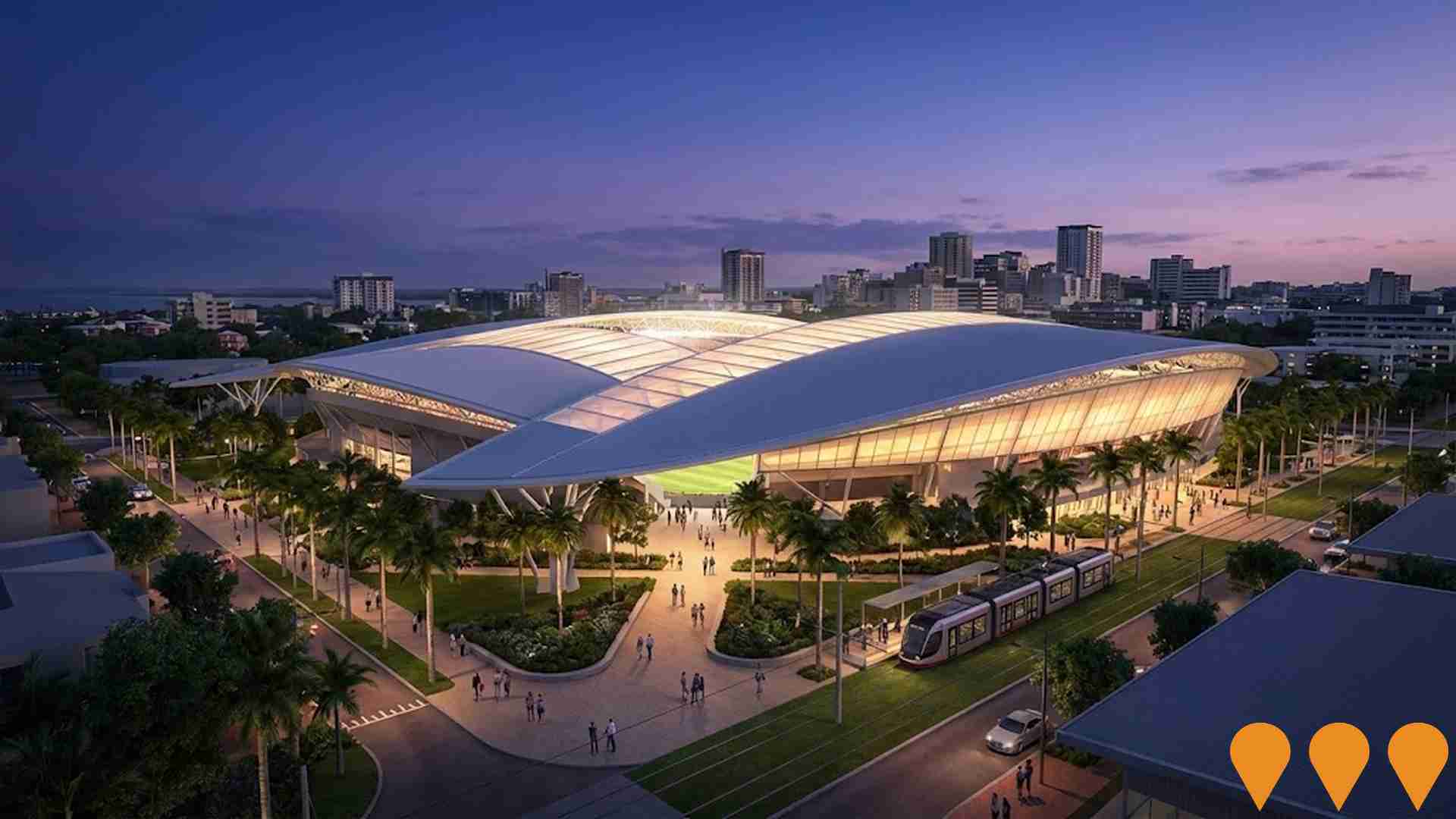
Darwin City Deal - Cavenagh Street Redevelopment
Comprehensive revitalisation of Cavenagh Street anchored by the newly completed $250 million Charles Darwin University 'Danala' City Campus and extensive streetscape upgrades. The project delivered a cooling, pedestrian-friendly civic spine with the 'Greening and Cooling' enhancement works completed in May 2024, featuring heat mitigation infrastructure and improved public realm connectivity. While the main Cavenagh Street precinct works are complete, the adjacent $30 million Civic Centre redevelopment on Harry Chan Avenue is progressing through planning.
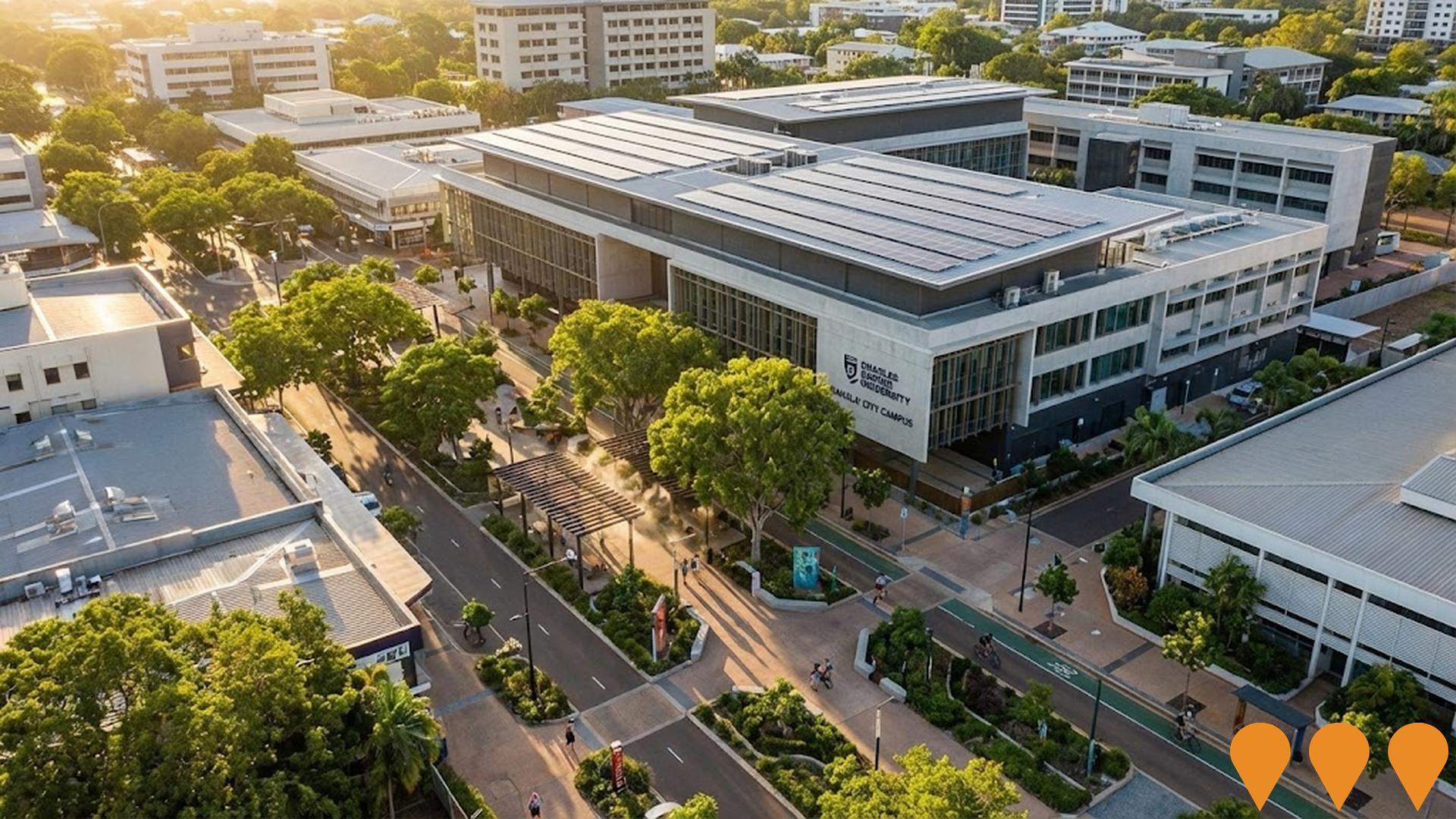
Darwin Galleria (Former Coles Site Redevelopment)
Redevelopment of the prominent 'former Coles site' in the Darwin CBD into a mixed-use precinct. The approved 'Darwin Galleria' proposal features a revitalized retail podium with a supermarket, specialty stores, and dining options, integrated with potential upper-level accommodation or hotel facilities to activate the city center.
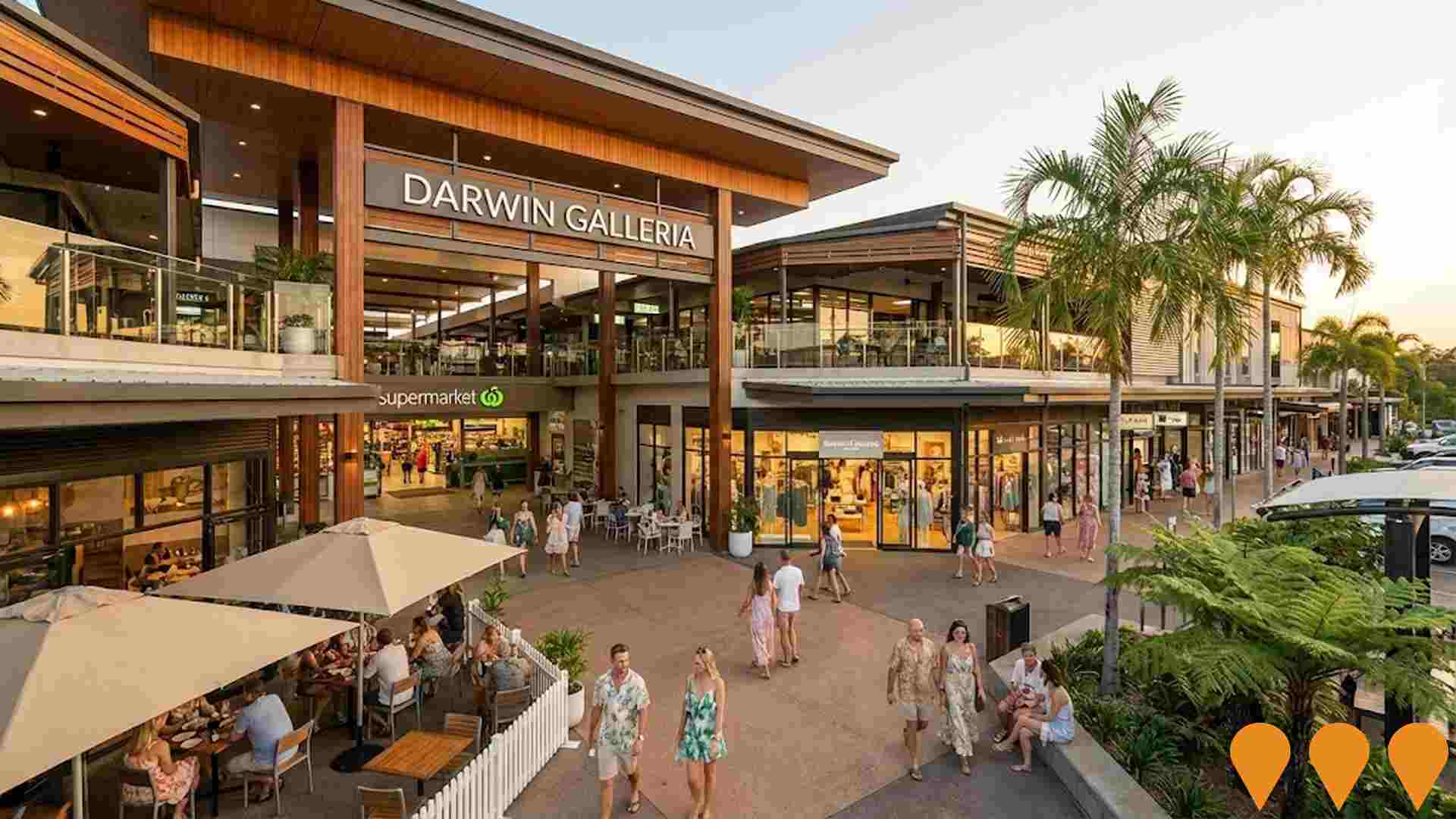
Mitchell Centre Redevelopment (Stage 1)
Multi-stage revitalisation of the Mitchell Centre triggered by the relocation of the major tenant, Power and Water Corporation, to the Ben Hammond Complex. The project involves the refurbishment of the 14-storey tower, offering potential for adaptive reuse into residential or hotel accommodation, alongside upgrades to the retail and food precinct anchored by Coles. Early works have included kitchen refurbishments on levels 10-14.
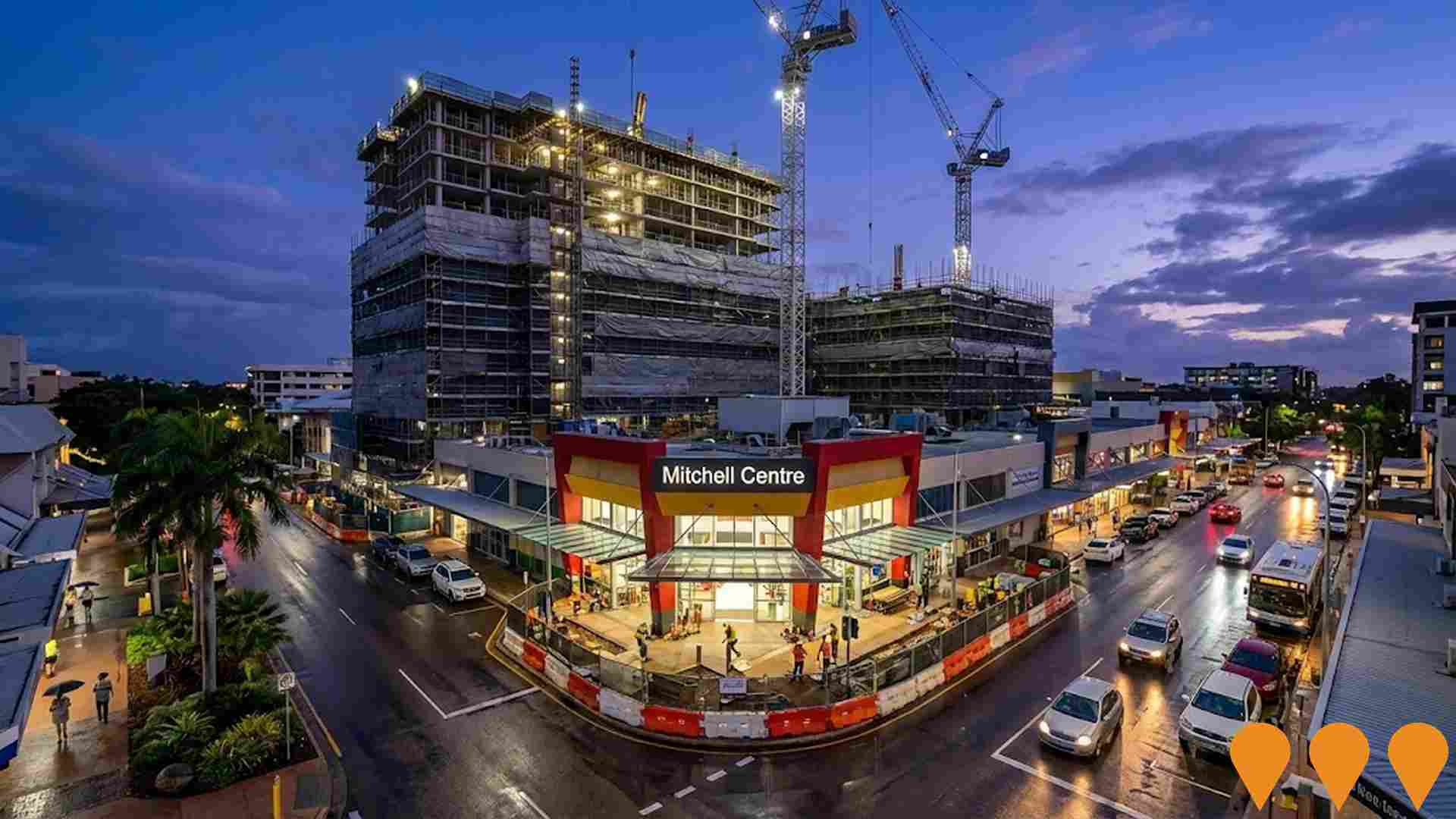
Darwin Waterfront Central Precinct Redevelopment
Major $250 million redevelopment featuring Australia's first saltwater surf park, tropical lagoon, new waterfront pools, Entry Plaza and Celebration Lawns, Convention Centre Hotel, and 2.8 hectares of additional public parklands.
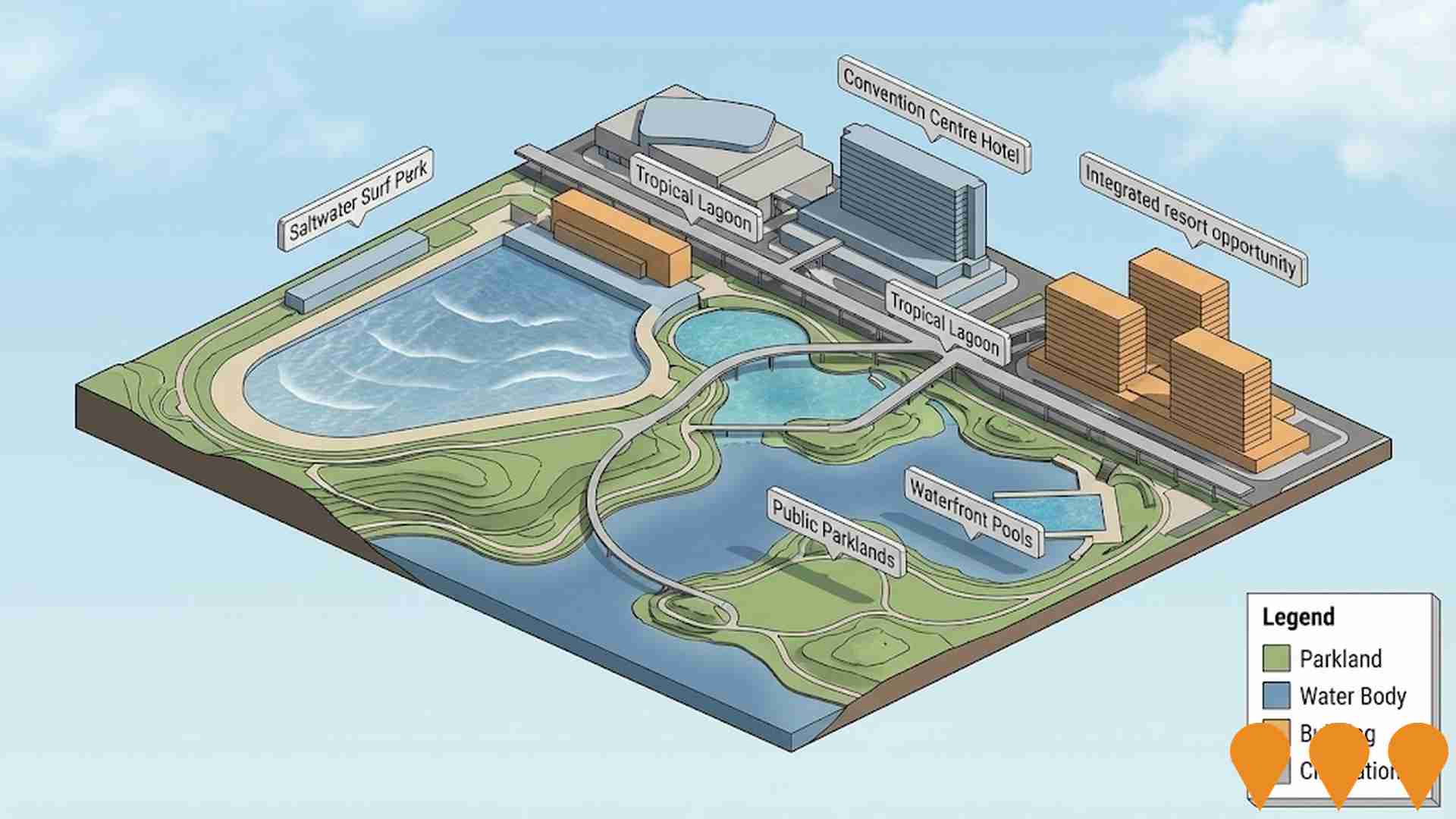
Civic and State Square Precinct Revitalisation
Revitalisation of the Civic and State Square Precinct in Darwin CBD to deliver shady parklands, public art, and better connections across Parliament House, Supreme Court and Government House. Works already completed include the 450-bay underground car park, native gardens and Chan Lawns, along with the former 90-bay parliamentary car park being converted to public lawns. The NT Art Gallery building has reached roof slab but the new government has put the gallery use under review via an EOI while construction activity on the building shell has progressed.
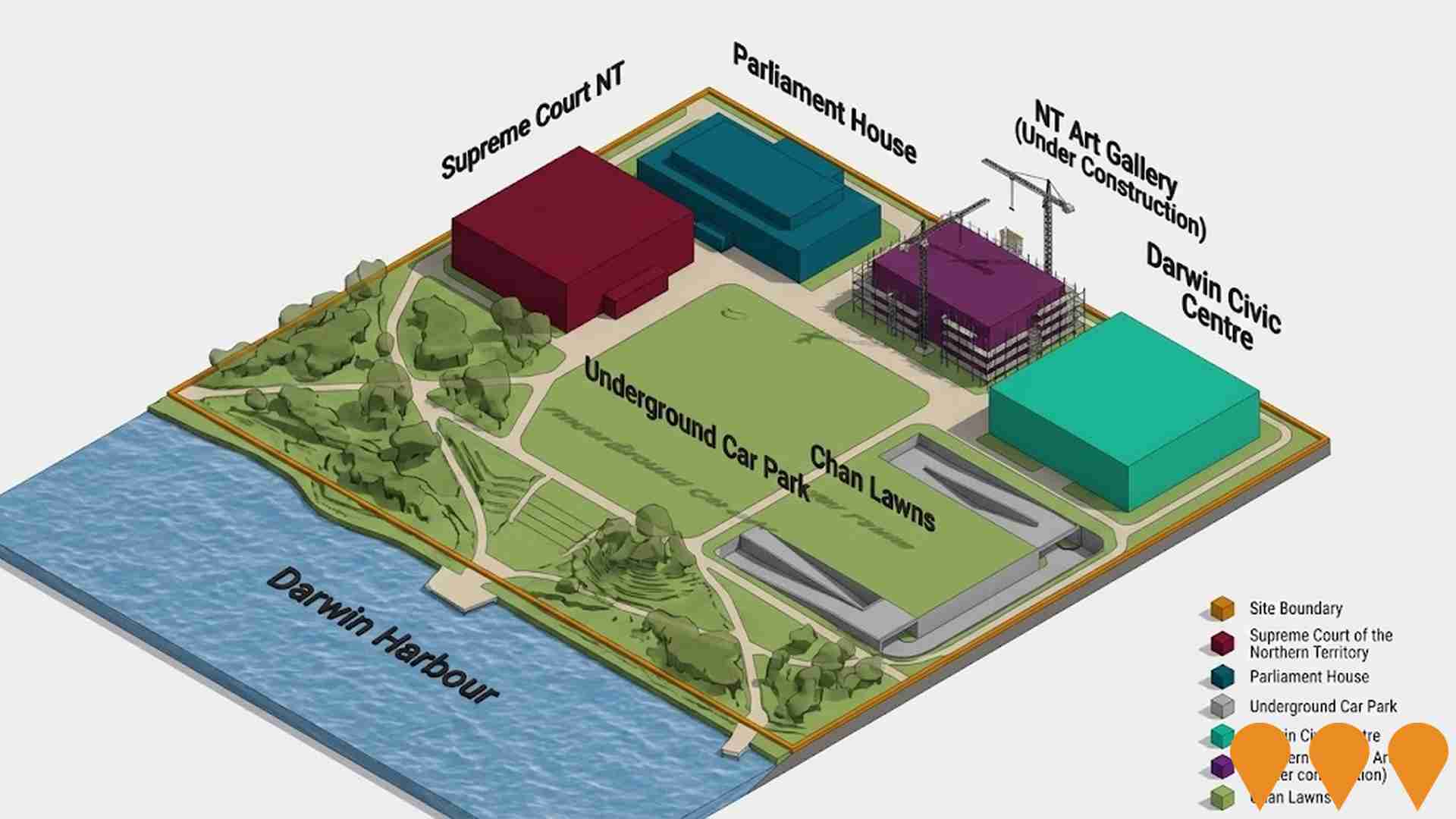
Charles Darwin University City Campus
$95 million new city campus featuring modern lecture halls, research facilities, and student accommodation to expand higher education access in Darwin CBD.
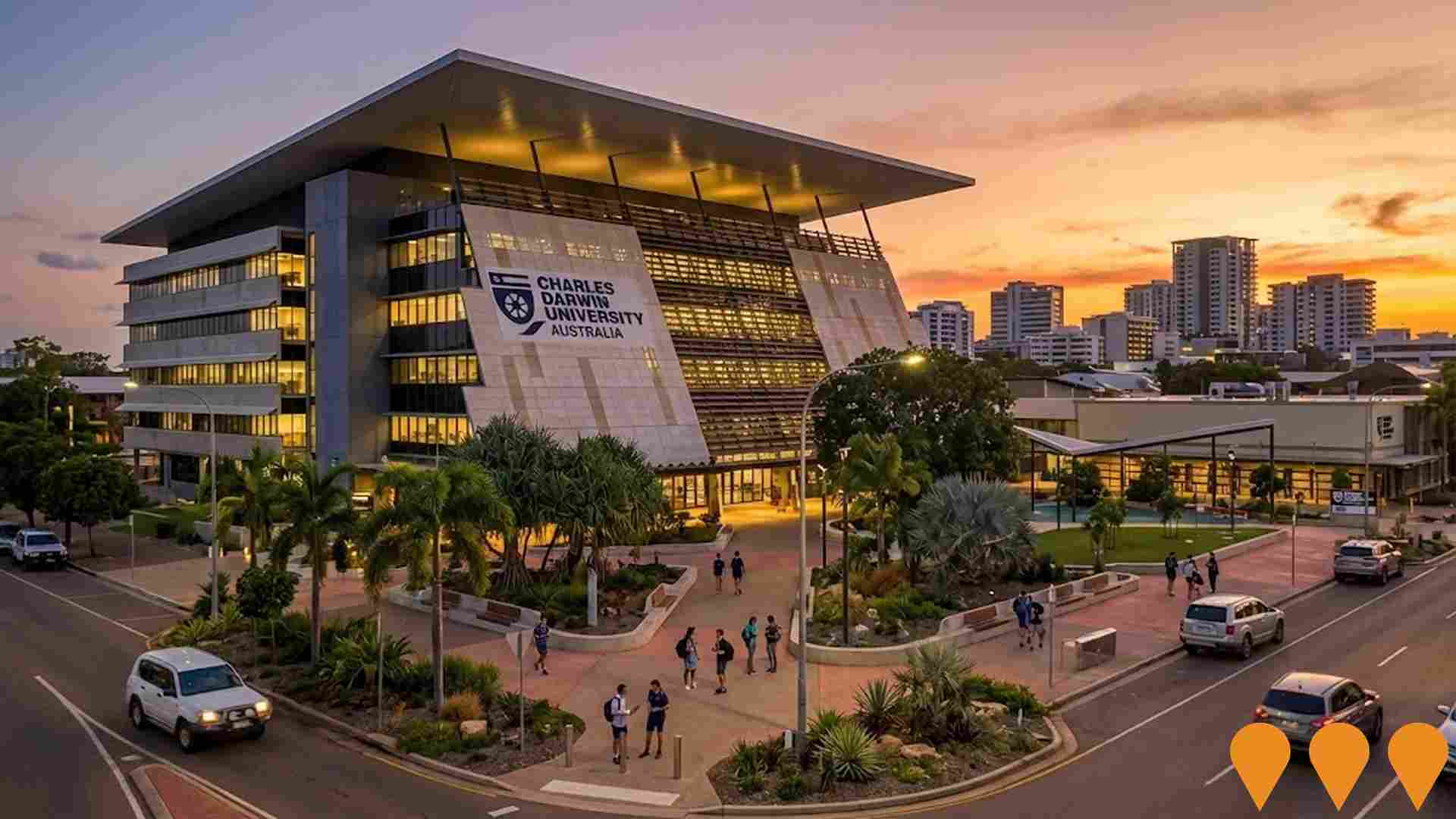
Stuart Highway Road Safety Improvements - Stuart Park
Road safety upgrades along Stuart Highway in Stuart Park to separate turning traffic from through traffic and provide full protection for pedestrians and cyclists at signals. Concept designs indicate dedicated left turn lanes at Armidale Street, Eden Street, Charles Street and Westralia Street, with improved line marking and signage. Project is in early design planning; construction subject to funding following detailed design.
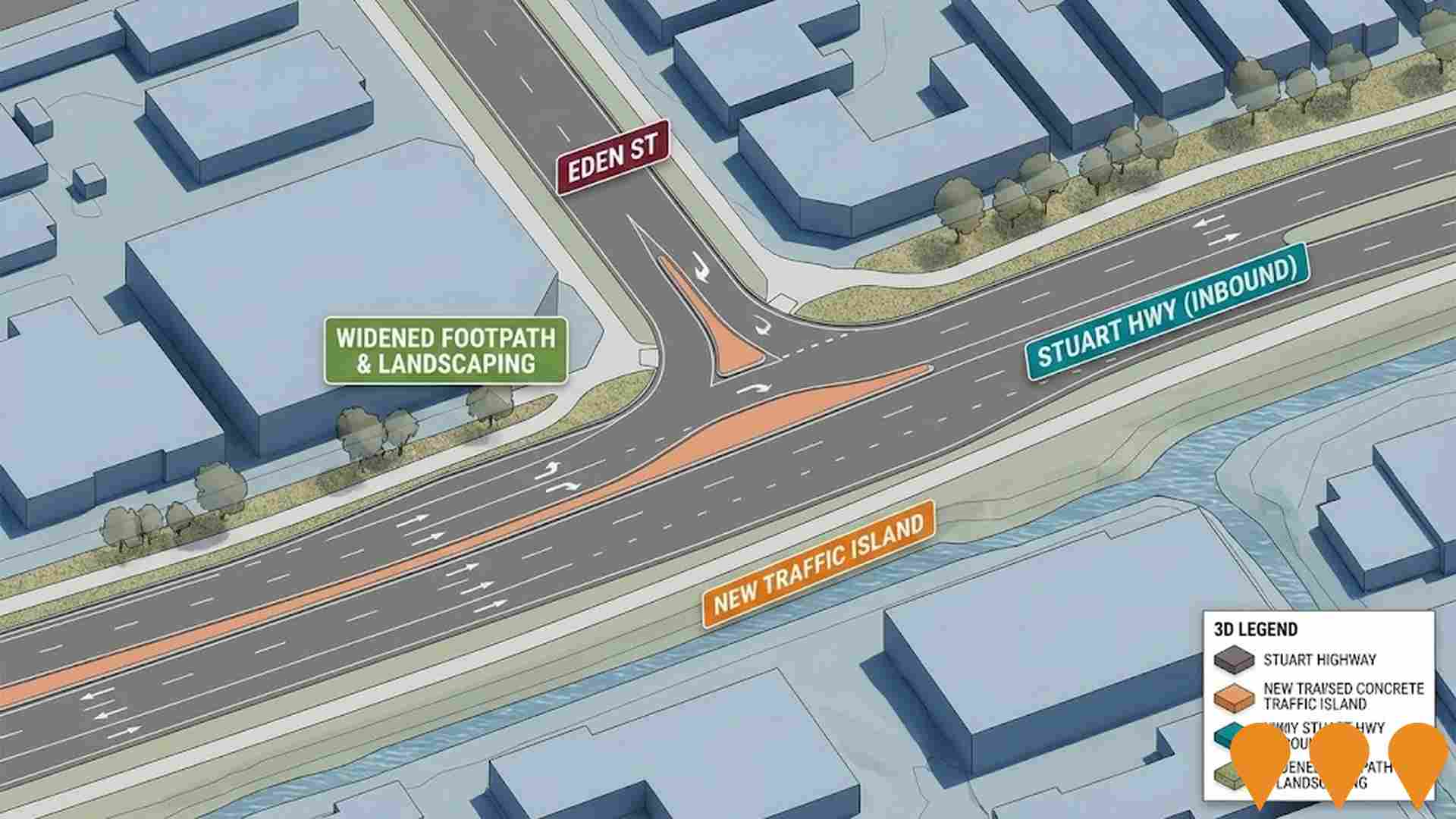
Employment
Employment conditions in Darwin City demonstrate exceptional strength compared to most Australian markets
Darwin City has an educated workforce with prominent representation in essential services sectors. Its unemployment rate is 2.6%, lower than the national average of 3.0%.
In the past year, employment grew by an estimated 2.9%. As of June 2025, 5,919 residents are employed, with an unemployment rate of 0.5% below Greater Darwin's rate. Workforce participation is higher at 75.8%, compared to Greater Darwin's 69.7%. Key industries include public administration & safety, accommodation & food, and health care & social assistance.
Accommodation & food has a strong presence with an employment share of twice the regional level, while construction shows lower representation at 5.3% versus the regional average of 9.2%. The area functions as an employment hub with 1.9 workers per resident, hosting more jobs than residents and attracting workers from nearby areas. Employment levels increased by 2.9% during the year to June 2025, with labour force increasing by the same percentage and unemployment remaining stable. Jobs and Skills Australia's national employment forecasts from May 2025 project national employment growth of 6.6% over five years and 13.7% over ten years. Applying these projections to Darwin City's employment mix suggests local growth of approximately 6.3% over five years and 13.0% over ten years, though this is a simple extrapolation for illustrative purposes only.
Frequently Asked Questions - Employment
Income
Income metrics indicate excellent economic conditions, with the area achieving higher performance than 75% of national locations assessed by AreaSearch
Darwin City's median income among taxpayers was $62,290 in financial year 2022. The average income stood at $73,761 during the same period. For Greater Darwin, these figures were $65,522 and $75,260 respectively. Based on a Wage Price Index growth of 12.01% since financial year 2022, current estimates for Darwin City would be approximately $69,771 (median) and $82,620 (average) as of September 2025. According to census data, individual earnings in Darwin City stand out at the 93rd percentile nationally ($1,236 weekly). The income bracket of $1,500 - 2,999 dominated with 42.7% of residents (3,416 people), aligning with the broader area where this cohort represented 36.7%. High housing costs consumed 19.0% of income in Darwin City, yet strong earnings placed disposable income at the 71st percentile nationally. The area's SEIFA income ranking placed it in the 8th decile.
Frequently Asked Questions - Income
Housing
Darwin City features a more urban dwelling mix with significant apartment living, with a higher proportion of rental properties than the broader region
Darwin City's dwelling structure, as per the latest Census, comprised 0.5% houses and 99.4% other dwellings (semi-detached, apartments, 'other' dwellings). In comparison, Darwin metro had 23.6% houses and 76.4% other dwellings. Home ownership in Darwin City was at 7.9%, with mortgaged dwellings at 15.1% and rented ones at 77.0%. The median monthly mortgage repayment was $1,781, below the Darwin metro average of $2,000. The median weekly rent was $450, compared to Darwin metro's $420. Nationally, Darwin City's mortgage repayments were lower than the Australian average of $1,863, while rents were substantially higher at $375.
Frequently Asked Questions - Housing
Household Composition
Darwin City features high concentrations of group households and lone person households, with a lower-than-average median household size
Family households account for 51.4% of all households, including 13.2% that are couples with children, 32.3% that are couples without children, and 4.3% that are single parent families. Non-family households make up the remaining 48.6%, with lone person households at 38.4% and group households comprising 10.2%. The median household size is 2.0 people, which is smaller than the Greater Darwin average of 2.3.
Frequently Asked Questions - Households
Local Schools & Education
Darwin City shows strong educational performance, ranking in the upper quartile nationally when assessed across multiple qualification and achievement indicators
Darwin City's educational attainment is notably high with 51.1% of residents aged 15 and above holding university qualifications, compared to 27.3% in the Northern Territory (NT) and 30.4% nationally. Bachelor degrees are most prevalent at 31.0%, followed by postgraduate qualifications at 16.6% and graduate diplomas at 3.5%. Vocational credentials are also common, with 28.2% of residents holding such qualifications, including advanced diplomas (12.5%) and certificates (15.7%). Educational participation is high, with 31.5% of residents currently enrolled in formal education, comprising 13.1% in tertiary, 5.0% in primary, and 3.4% in secondary education.
St Mary's Catholic Primary School serves the local area, with an enrollment of 180 students as of a recent report. The school focuses exclusively on primary education, with nearby areas offering secondary options. The area has above-average socio-educational conditions (ICSEA: 1071). Local school capacity is limited at 2.2 places per 100 residents compared to the regional average of 15.1, leading many families to seek schooling in nearby areas.
Frequently Asked Questions - Education
Schools Detail
Nearby Services & Amenities
Transport
Transport servicing is moderate compared to other areas nationally based on assessment of service frequency, route connectivity and accessibility
Darwin City has 12 active public transport stops operating within its boundaries. These stops are served by a total of 27 bus routes. Together, these routes facilitate 1,368 weekly passenger trips.
The accessibility of public transport in Darwin City is rated as good, with residents on average located 219 meters from the nearest transport stop. Across all routes, service frequency averages 195 trips per day, which equates to approximately 114 weekly trips per individual stop.
Frequently Asked Questions - Transport
Transport Stops Detail
Health
Darwin City's residents boast exceedingly positive health performance metrics with very low prevalence of common health conditions across all age groups
Health outcomes data shows excellent results across Darwin City, with very low prevalence of common health conditions across all age groups. Private health cover rate is high at approximately 56% of the total population (~4,520 people), compared to 61.3% across Greater Darwin.
Mental health issues and asthma are the most common medical conditions in the area, affecting 5.2 and 5.0% of residents respectively. 82.6% of residents declare themselves completely clear of medical ailments, compared to 79.9% across Greater Darwin. The area has 9.0% of residents aged 65 and over (719 people), lower than the 11.0% in Greater Darwin. Health outcomes among seniors are particularly strong, broadly in line with the general population's health profile.
Frequently Asked Questions - Health
Cultural Diversity
Darwin City is among the most culturally diverse areas in the country based on AreaSearch assessment of a range of language and cultural background related metrics
Darwin City has a notable cultural diversity, with 40.4% of its population speaking a language other than English at home and 51.7% born overseas. Christianity is the predominant religion in Darwin City, comprising 31.7% of people. Hinduism is overrepresented compared to Greater Darwin, making up 11.7% of Darwin City's population, while regionally it stands at 7.4%.
In terms of ancestry, English (20.9%), Other (20.2%) and Australian (14.6%) are the top three represented groups in Darwin City. Notably, Korean is overrepresented at 0.9% compared to the regional average of 0.4%, Sri Lankan stands at 0.7% (matching regionally), and Filipino is slightly underrepresented at 2.6% compared to the regional figure of 2.9%.
Frequently Asked Questions - Diversity
Age
Darwin City's young demographic places it in the bottom 15% of areas nationwide
Darwin City's median age stands at 33 years, comparable to Greater Darwin's average of 34 and notably lower than Australia's median of 38. Compared to Greater Darwin, Darwin City has a higher proportion of residents aged 25-34 (32.4%) but fewer individuals aged 5-14 (4.9%). This concentration of 25-34 year-olds is significantly higher than the national average of 14.5%. Post-2021 Census data indicates that the 65 to 74 age group has increased from 5.5% to 6.4% of the population, while the 55 to 64 cohort has decreased from 9.9% to 8.4%, and the 25 to 34 group has dropped from 33.6% to 32.4%. By 2041, demographic modeling projects significant changes in Darwin City's age profile. The 45 to 54 age cohort is projected to grow steadily by 396 people (42%) from 953 to 1,350. Meanwhile, the 0 to 4 cohort is expected to grow modestly by 7% (20 people).
